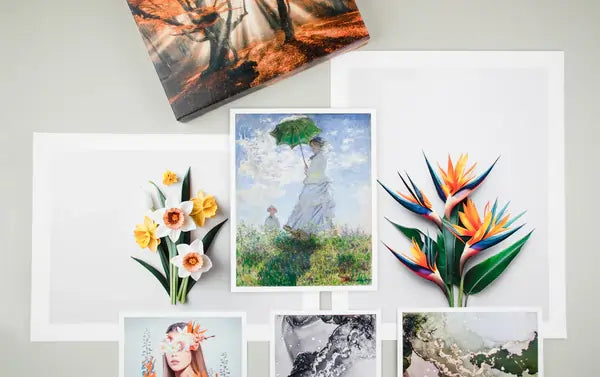
How Giclee Printing Is Different From Other Printing Methods
Professional artists should consider making prints of their fine art. After all, it’s an incredible way to generate income beyond selling your original masterpiece. Art reproductions are perfect for online stores, galleries, and art shows. Hobbyists also may want to consider printing their creative endeavors to share them with friends and family.
Whether you’re an artist or a hobbyist, you might wonder how Giclee printing differs from other printing methods. We’re going to discover the answer to that and more.
A Brief History of Giclee Printing
Jack Duganne was the father of Giclee printing. He took inspiration from the French word giclée (pronounced gee-clay), which translates as “to spray a liquid.” Duganne came up with the idea in 1991 because he wanted to invent a printing method that stood apart from the competition. He succeeded in developing this innovative technology that we continue to use today.
Modern Giclee Printing Technology
At The Stackhouse, we define Giclee as a high-quality print created using state-of-the-art printing technology. We achieve this with modern inkjet printers and archival pigment inks. Our superior method helps your artistic images last for years to come. Giclee printing also preserves the integrity of the original piece by replicating the colors the artist used.
In addition to this printing service, our team offers you help every step of the way with unparalleled customer service. We make it easy for you to figure out how to upload your media on our website and complete the ordering process online. Our team of professionals takes out the guesswork, so you will have a print you love that’s perfect for sharing in just about any size.
Canvas Prints
While you may feel tempted to print your art at home, most printing technology from the big box stores can’t accomplish what professional Giclee printers can do. We provide the unique option to produce fine art giclee prints on canvas. This eye-catching display helps capture the magic of the original artwork. It’s an outstanding choice for displaying traditional art, digital art, and photography.
With your art reproduced that way, you can feel proud to display it anywhere, whether at home, in a gallery, or in a museum. You have the option to choose either a satin or matte finish that helps increase the longevity of your masterpiece. The exhibition canvas we use guarantees the best quality.
We offer several types of canvas products to help your vision come to life:
Other Types of Prints
In addition to canvas prints, we offer:
Fine Art and Photography Prints
Choose from an array of high-quality papers for fine art prints, from Hot Press Bright to FineArt Baryta. We also offer several types of photography papers by Epson. Whether you want a traditional feel or something completely different, we got you covered. If you need clarification on what kind of paper you want, request free samples here.
Matted Prints
Our matted prints are also a dream for any art professional. Acid-free tape adheres your image to our beautiful snowy-white matboard. With this impressive display accenting your piece, you can have a ready product for your supporters to buy.
Production Time
The Stackhouse provides artists, photographers, and hobbyists with plenty of affordable options to obtain high-quality Giclee prints. We have a quick production time that ranges from two to five business days, depending on your desired quantity. The type of print you choose may also affect production time. Please note that this estimate does not include shipping time.
After touching on all the benefits Giclee printing offers and the products we use, let’s look at how Giclee printing differs from other printing methods.
Lithograph Printing
Before we had such advanced digital techniques, people relied on lithograph printing. This ancient process originally used limestone. Artists would draw their creations directly onto the stone with a special pencil containing grease. They applied different chemicals to the limestone that helped transfer their art.
After a lengthy chemical process, they washed the greasy materials away from the stone, leaving a faint image of the original drawing. Several more steps took place before they had a product ready for printing.
People still practice this ancient type of printmaking at museums and schools. Lithography certainly gives us an appreciation of how Giclee printing streamlines the entire process with digital innovations.
Offset Lithography
Over the years, lithograph printing evolved into offset lithography, also known as offset printing. Like its ancient ancestor, the process still involves getting an etching of the original creation, though this currently gets done on metal plates rather than stones. A laser accomplishes the etchings now instead of a pencil.
The metal plates are sent through advanced printing machines using CMYK technology for color prints. CMYK stands for cyan, magenta, yellow and black. A plate cylinder puts all the working parts in motion, and one color is captured at a time, eventually leading to the combination you need.
This modern version does well when you want to print in massive quantities. Businesses often utilize offset lithography to create the flyers or catalogs you receive in the mail. While this does a good job of capturing colors for those purposes, pinpointing the full spectrum of color in your art is challenging for offset lithography. Most artists or hobbyists also don’t require as many prints as businesses, making Giclee the ideal printing process.
Digital Printing
While Giclee is a form of digital printing for fine art, standard digital printing exists for other purposes. This process can happen on any printer at home or in the office. However, even if you invest in quality paper, you’ll notice a significant need for more quality when printing out artwork. The ink in most digital printing differs from the archival quality we utilize for Giclee printing.
If you’re creating something temporary, digital printing works fine. An example is printing some flyers announcing an upcoming event. These are only meant to last a few months at most. Giclee is ultimately the route to take when thinking of fine art, as it will last for many years.
Printing has a fascinating history. Ancient technologies like lithography paved the way for later digital innovations. Thanks to Giclee printing, artists, photographers, and hobbyists have a dynamic printing method at their disposal. They can create breathtaking prints of fine art that are fit for display, whether for resale or home decoration.





